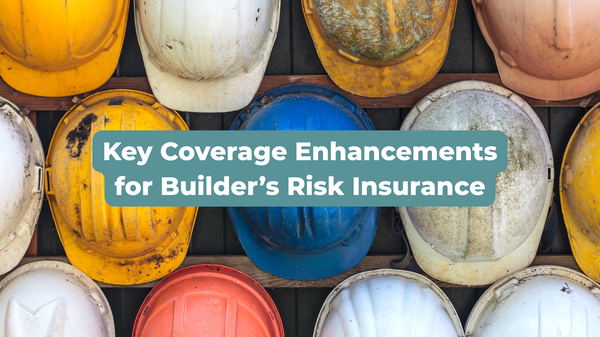Why Waiting on Builder’s Risk Insurance Could Derail Your Project (And How to Avoid It)
Posted:
1 month, 2 weeks
ago
(0 comments)
Builder’s Risk Insurance: Why Timing Matters & Key Coverage Enhancements You Shouldn’t Miss
When it comes to construction, timing is everything — and this includes securing the right insurance. One of the most common (and costly) mistakes we see is when contractors or project owners try to secure Builder’s Risk insurance after construction has already begun, or worse, when the project is already 50% complete. While it’s still possible to get coverage at that stage, the process becomes significantly more challenging, and the costs can be astronomical compared to purchasing insurance before the first shovel hits the ground.
In this blog, we'll explain why securing Builder’s Risk early is critical and explore the key coverage enhancements that can safeguard your project from unforeseen risks.
The Risk of Waiting: Why Builder’s Risk Insurance Should Be a Priority
Builder’s Risk insurance is designed to protect construction projects from damage or loss caused by a range of perils, including fire, theft, vandalism, weather, and more. The earlier you secure coverage, the better positioned you are to:
- Lock in Lower Premiums: Insurers see projects that are already underway as higher risk. They worry about undetected damages or potential safety issues that weren’t accounted for early on. The result? Significantly higher premiums, sometimes double or triple the cost if you had purchased it before starting construction.
- Avoid Coverage Gaps: By obtaining coverage after construction has started, you risk missing out on certain protections, like those tied to early project milestones, pre-construction inspections, and foundation assessments. Without those, the insurer has less certainty about the project’s true condition, which limits your coverage options.
- Limited Market Availability: When you wait, fewer insurers are willing to take on the risk, which restricts your options. This is especially true for high-risk projects, such as cannabis facilities. Cannabis-related projects already face unique challenges when it comes to insurance due to regulatory concerns and the risks associated with the industry. Finding Builder’s Risk insurance after construction has begun on a cannabis facility can feel like searching for a needle in a haystack. The market options dwindle, and when you do find coverage, be prepared for sky-high premiums.
Key Coverage Enhancements to Strengthen Your Builder’s Risk Policy
Even if you secure Builder’s Risk insurance early, it’s essential to tailor your policy with key coverage enhancements to protect your investment from every angle. Here are some must-have endorsements:
- Soft Costs Coverage
When delays happen due to a covered event, the costs go beyond physical damage. Soft costs like additional interest on loans, legal fees, architectural rework, and more can add up fast. This enhancement ensures those expenses are covered.
- Materials in Transit and Off-site Storage
Construction materials often have to travel before reaching the site. Protect your investment with coverage for materials in transit or stored temporarily off-site to avoid losing thousands of dollars in damaged or stolen supplies.
- Equipment Breakdown
Construction projects rely on heavy machinery. If equipment breaks down mid-project, it can cause costly delays. This enhancement covers repair or replacement of vital equipment, keeping your project on track.
- Ordinance or Law Coverage
If you’re working on a renovation or building project that needs to comply with updated building codes, this coverage ensures that if part of the building is damaged, you’ll have the funds to meet new code requirements — not just repair the old structure.
- Debris Removal
After damage occurs, cleanup costs can be substantial. Debris removal coverage helps cover the cost of clearing damaged materials from the job site.
- Testing and Commissioning Coverage
For complex systems like HVAC, electrical, or plumbing, this coverage provides protection in case a system fails during testing and needs repairs or replacement.
- Pollutant Cleanup
Construction sites, especially in older buildings, can reveal hazardous materials like asbestos, mold, or lead. Pollutant cleanup coverage helps manage these surprise discoveries and covers the costs of safely removing them.
- Water Intrusion or Flood Coverage
Water damage, from rain or poor drainage systems, can wreak havoc on a construction project. Adding flood or water intrusion coverage protects your build from potential flooding damage.
- Additional Expenses for Expedited Work
If your project timeline is thrown off by a covered loss, getting it back on track might require hiring extra labor or working overtime. This enhancement covers the additional costs of expediting the work.
Builder’s Risk for Renovation Projects: Special Considerations
When it comes to renovation projects, securing Builder’s Risk insurance is just as crucial as for new builds — but it comes with unique challenges and considerations.
Here’s what to keep in mind when insuring a renovation project:
- Coverage for Existing Structures: Standard Builder’s Risk policies typically focus on the new construction portion of a project. However, if you’re renovating an existing building, you’ll need to specifically include coverage for the existing structure itself, not just the new additions or updates. Without this, any damage to the original building may not be covered.
- Protection Against Hidden Hazards: Renovations often uncover unexpected risks like faulty wiring, asbestos, or structural weaknesses. Make sure your policy includes pollutant cleanup and ordinance or law coverage to address these issues when they arise.
- Partial Occupancy Clauses: Many renovation projects take place in buildings that are partially occupied during construction. This creates a unique risk because standard Builder’s Risk policies may not cover losses in spaces that are actively in use. In this case, you may need an endorsement or tailored policy to include partial occupancy coverage.
- Increased Risk of Damage: Renovation sites can be more prone to damage than new builds due to age-related wear and tear, existing vulnerabilities, or integration with older structures. Ensuring you have broad form perils coverage can help mitigate these risks, covering everything from fire to water intrusion to vandalism.
- Debris Removal and Site Cleanup: Renovations often generate significant debris, especially if the project involves demolition. A debris removal clause ensures you’re covered for the additional costs of clearing the site after an unexpected loss.
Whether your renovation is small or involves a complete overhaul, Builder’s Risk insurance is essential to protecting the investment and ensuring that both the new construction and the existing structure are covered from potential risks.
The Bottom Line: Protect Your Project Early and Completely
Builder’s Risk insurance isn’t just a formality — it’s a critical layer of protection that can save you from crippling losses. The earlier you secure it, the better the terms, pricing, and coverage options available. Don’t let your project face unnecessary delays, financial strain, or gaps in protection by waiting too long.
For cannabis-related construction projects, this is even more critical. The complexity of the industry makes it harder to secure coverage in the first place, and waiting until the project has already begun will likely mean fewer market options and significantly higher costs.
Whether you’re building a standard commercial property or a specialized facility, make Builder’s Risk insurance a top priority before breaking ground. If you’re unsure of the best coverage for your project, we’re here to help — from selecting the right policy to understanding critical coverage enhancements that can save you down the road.
If you’d like to know more about Builder’s Risk insurance and how it can protect your next project, reach out to us today. Let’s make sure your build is covered from start to finish — the right way.
Share on Facebook


Comments
There are currently no comments
New Comment